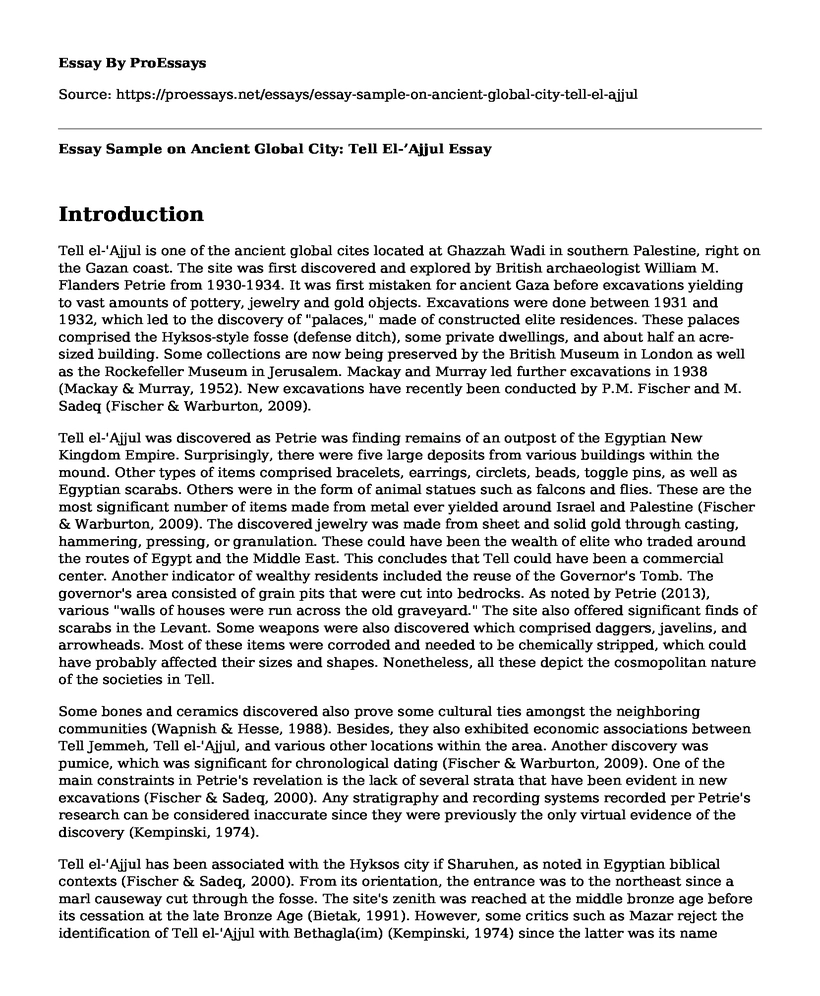Introduction
Tell el-'Ajjul is one of the ancient global cites located at Ghazzah Wadi in southern Palestine, right on the Gazan coast. The site was first discovered and explored by British archaeologist William M. Flanders Petrie from 1930-1934. It was first mistaken for ancient Gaza before excavations yielding to vast amounts of pottery, jewelry and gold objects. Excavations were done between 1931 and 1932, which led to the discovery of "palaces," made of constructed elite residences. These palaces comprised the Hyksos-style fosse (defense ditch), some private dwellings, and about half an acre-sized building. Some collections are now being preserved by the British Museum in London as well as the Rockefeller Museum in Jerusalem. Mackay and Murray led further excavations in 1938 (Mackay & Murray, 1952). New excavations have recently been conducted by P.M. Fischer and M. Sadeq (Fischer & Warburton, 2009).
Tell el-'Ajjul was discovered as Petrie was finding remains of an outpost of the Egyptian New Kingdom Empire. Surprisingly, there were five large deposits from various buildings within the mound. Other types of items comprised bracelets, earrings, circlets, beads, toggle pins, as well as Egyptian scarabs. Others were in the form of animal statues such as falcons and flies. These are the most significant number of items made from metal ever yielded around Israel and Palestine (Fischer & Warburton, 2009). The discovered jewelry was made from sheet and solid gold through casting, hammering, pressing, or granulation. These could have been the wealth of elite who traded around the routes of Egypt and the Middle East. This concludes that Tell could have been a commercial center. Another indicator of wealthy residents included the reuse of the Governor's Tomb. The governor's area consisted of grain pits that were cut into bedrocks. As noted by Petrie (2013), various "walls of houses were run across the old graveyard." The site also offered significant finds of scarabs in the Levant. Some weapons were also discovered which comprised daggers, javelins, and arrowheads. Most of these items were corroded and needed to be chemically stripped, which could have probably affected their sizes and shapes. Nonetheless, all these depict the cosmopolitan nature of the societies in Tell.
Some bones and ceramics discovered also prove some cultural ties amongst the neighboring communities (Wapnish & Hesse, 1988). Besides, they also exhibited economic associations between Tell Jemmeh, Tell el-'Ajjul, and various other locations within the area. Another discovery was pumice, which was significant for chronological dating (Fischer & Warburton, 2009). One of the main constraints in Petrie's revelation is the lack of several strata that have been evident in new excavations (Fischer & Sadeq, 2000). Any stratigraphy and recording systems recorded per Petrie's research can be considered inaccurate since they were previously the only virtual evidence of the discovery (Kempinski, 1974).
Tell el-'Ajjul has been associated with the Hyksos city if Sharuhen, as noted in Egyptian biblical contexts (Fischer & Sadeq, 2000). From its orientation, the entrance was to the northeast since a marl causeway cut through the fosse. The site's zenith was reached at the middle bronze age before its cessation at the late Bronze Age (Bietak, 1991). However, some critics such as Mazar reject the identification of Tell el-'Ajjul with Bethagla(im) (Kempinski, 1974) since the latter was its name during its floruit in the Bronze age. However, the main weakness in the arguments made by critics is that the Tell is not associated with any identification of its name in the past (Kempinski, 1974). Nonetheless, Tell el-'Ajjul remains to be the most significant archaeological site of modern times.
References
Fischer, P. M., & Sadeq, M. (2000). Tell El-ajjul 1999: A Joint Palestinian-Swedish Field Project: First Season Preliminary Report. Agypten und Levante/Egypt and the Levant, 10, 211-226.
Fischer, P. M., & Warburton, D. A. (2009). The chronology of Tell el-Ajjul, Gaza: Stratigraphy, Thera, pumice and radiocarbon dating. In Time's Up! Dating the Minoan Eruption of Santorini. Acts of the Minoan Eruption Chronology Workshop, Sandbjerg, November 2007 (pp. 253-265). Danish Institute at Athens.
Bietak, M., (1991). Egypt and Canaan during the Middle Bronze Age. Bulletin of the American Schools of Oriental Research, 281(1), 27-72.
Kempinski, A., (1974). Tell el-'Ajjul-Beth-Aglayim or Sharuen?. Israel Exploration Journal, 145-152.
Mackay, E. J. H., & Murray, M. A. (1952). Ancient Gaza V. The city of Shepherd Kings.
Petrie, W. M. F. (2013). Ancient Gaza (Vol. 2). Cambridge University Press.
Wapnish, P., & Hesse, B., (1988). Urbanization and the organization of animal production at Tell Jemmeh in the Middle Bronze Age Levant. Journal of Near Eastern Studies, 47(2), 81-94.
Cite this page
Essay Sample on Ancient Global City: Tell El-'Ajjul. (2023, Jan 16). Retrieved from https://proessays.net/essays/essay-sample-on-ancient-global-city-tell-el-ajjul
If you are the original author of this essay and no longer wish to have it published on the ProEssays website, please click below to request its removal:
- War and Oppression During the Battle of Stalingrad
- The Rise of Fascism, World War II and the Holocaust Essay
- Essay Example on Celibacy, Monasticism, Scholasticism: Ancient Living and Teaching
- Essay Example on God Bless the Child: US Response to Juvenile Prostitution
- Lori Fried: German-American Socialist Educator in 1892 Missouri - Essay Sample
- Essay Sample on Ford Motor: Committed to Team-Based Automotive Manufacturing
- Thomas Graham: Pioneering Chemistry through Graham's Law of Diffusion and Scientific Contributions - Free Paper







